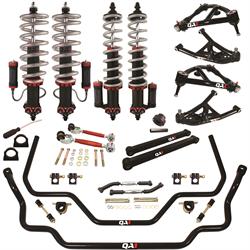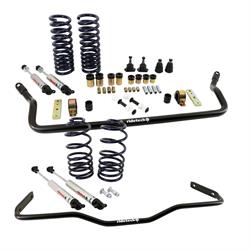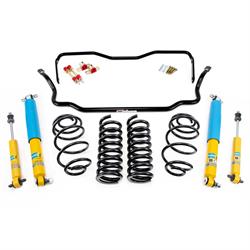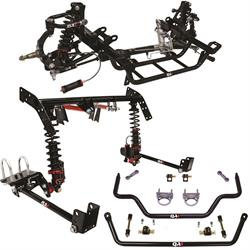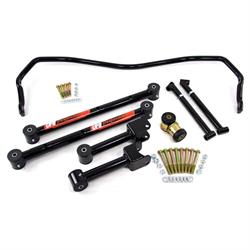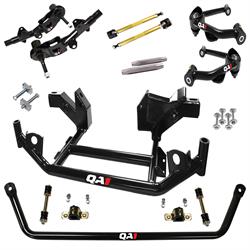Muscle Car Suspension Upgrades | Restomod vs Pro Touring Classic Car
Classic Car Suspension Upgrades | Pro Touring VS Restomod
We’ve all heard the term “Pro Touring” thrown around a lot in the last couple decades. The image that comes to mind for most of us is a classic American muscle car that’s slammed on the ground with big wheels, wide rubber on all four corners, big brakes, and big power. The idea is to make that old muscle machine perform more like a modern supercar, and the performance aftermarket has come up with lots of ways to get there. These days, it’s possible to make your car handle better with a few bolt-ons, or go all-in on a complete suspension transformation that’s more Maserati than muscle car. Which is right for you? Let’s take a closer look at the muscle car suspension options that are available and discuss the pros and cons of each.
Suspension Upgrades for Restomod Muscle Car VS Suspension for Pro Touring Cars
Before we get started here, let’s establish some of the terms we’ll be using. We’re going to compare what we’re calling a “restomod” car to full-tilt Pro Touring cars. For this discussion, let’s define restomod meaning as a muscle car that has a few bolt-on parts to make it perform better than it did when it rolled out of the showroom, but still retains the character and charm of an old car. These are cars modified with things like lowering springs, sway bars, wheels and tires, a disc brake upgrade, and more power in front of a modern gearbox. When comparing Pro Touring vs restomod, a Pro Touring car may have more aggressive modifications like a completely re-engineered suspension, big brakes with supercar tech baked in, and more modern tech throughout the car. Depending on execution, these cars can feel more like a brand-new Corvette than a creaky old muscle car. So, let’s begin by discussing a “restomod” muscle car and a few of the common modifications and their effects.
Do Lowering Springs Affect Ride Quality?
This is one of the first things many of us want to do when a sky-high stocker rolls into our garage. Lowering a car is a staple in the restomod playbook and it’s a quick way to improve a car’s handling around corners and make it look like the low and mean machine that we’re picturing in our minds. But what are lowering springs actually doing to your car’s geometry and ride quality?
First, let’s talk about the physics and geometry of lowering a car. Dropping a car’s body and chassis will lower its center of gravity. By moving the center of gravity closer to the suspension’s roll center, you’re shortening the lever arm that inertia has to cause body roll. Think of the difference between a ¼”-drive ratchet and a 1/2” breaker bar. So, all other things being equal, a lower center of gravity will decrease body roll and contribute to better handling.
Another thing that happens when a car is dropped with lowering springs is that the suspension geometry is changed, or at least the starting point is moved. Most cars with an independent front suspension system will gain negative camber as the suspension compresses. When you install lowering springs, you’re establishing a lower ride height, which is typically farther into the camber curve. With no other changes to the alignment, the car will likely have some negative camber in it when it hits the ground.
Another important thing to look at here is the spring rate, or the amount of force it takes to compress the springs. It’s important to understand that not all lowering springs are the same rate, and they’re not all the same rate as the stock springs. This can have a huge impact on the car’s ride quality. Generally speaking, a heavier spring rate will cause a rougher ride and less weight transfer and body roll under hard braking, acceleration, and cornering. Conversely, a softer spring will be more compliant over bumps, but allow for more weight transfer and body roll.
And to answer the age-old question, what if I just cut coils to lower my car? Well, this will not only lower the car, it will also increase the spring rate. Cars with cut coils will sit lower than stock, but also tend to ride rougher. Another thing to consider when lowering a car with springs is the proximity of the control arms and axle housing to the frame and bump stops. Lowering so much that the axle or suspension components are “bottoming out” on the bump stops or worse yet, the frame itself will create something that is unsafe, miserable to drive, and likely to be damaged over time. It may look cool, but it’s not worth it. Using mock up suspension tools while the car is in the shop is a great way to preview a lowered ride height and look for interference.
Is Air Suspension Good for Racing?
The ability to flip a switch from comfortable street driving to aggressive, slammed muscle machine makes air suspension a common upgrade on a restomod muscle car. Whether or not it’s a good solution for a car that will spend time on the track is subject to some debate, and you will find builders and racers on both sides of this issue. Air suspension allows for rapid and easy changes to ride height. Compared to a non-adjustable right height or the manual nature of adjusting coilovers with a spanner wrench, this can be advantageous for making quick changes to a car for improved handling around an autocross or road course. However, most serious race cars and dual-purpose cars favor the simplicity, light weight, and consistency of coilovers with adjustable shock valving. There are cars out there that are competitive on air suspension, but in our experience, adjustable coilovers bolted to a thoughtfully modified suspension make for the best track day setup.
What is a Pro Touring Car?
The idea of a muscle car that handles through the corners is nothing new. While dragstrip heroics were often the focus of the muscle car wars of the 60’s and 70’s, a quick look at the gnarly Penske/Donohue Camaros and Shelby Mustangs in vintage SCCA racing will reveal that muscle cars with four fat tires designed to keep pace with more exotic corner carvers have been around since the beginning. Then, in the early 90’s, magazine coverage of the antics of GM engineer Mark Stielow’s “Tri-Tip” ’69 Camaro stirred up interest in a muscle car that could do it all: compete on the road course, dragstrip, and then cruise down the road in relative comfort. The idea caught on, and for the last 25-years or so, Pro Touring has been a dominant trend in hopped up muscle cars. What is Pro Touring? This is the more extreme end of the spectrum when compared to a restomod. These cars are characterized by a low stance, big wheels and big tires all around, big brakes, maybe a roll bar or cage, and more often than not a late model engine under the hood built ro deliver dependable power.
Autocross racing has become one of the most popular places for Pro Touring muscle cars to compete. Sanctioning bodies like SCCA Solo and Goodguys offer extremely competitive places to race. What is autocross racing? Autocross courses are typically marked with cones and can be built anywhere there is a sufficiently large chunk of smooth concrete. While some are head-to-head, most are races against the clock. Generally, speeds are lower than on a road course and only one car is running at a time, lowering the risk of smashing up your investment. Though it’s relatively safe, most autocross clubs and sanctioning bodies will require at least a race helmet. Autocrossing is a great test of suspension, power, and braking improvements as well as a tremendous test of driving skill. As a driver, figuring out how to autocross is often more difficult than the nut and bolt work of how to build an autocross car with a beefed-up autocross suspension.
Best Pro Touring Front Suspension Upgrades
Determining what’s “best” for you and your Pro Touring muscle car is going to depend on an honest assessment of what you actually plan to do with the car. The best Pro Touring chassis mods and suspension setup for total domination on the autocross course is likely going to be miserable on the street. And the setup that allows for comfortable cruising is not going to put you on the podium at Laguna Seca. With that in mind, here’s a look at what’s available across the spectrum and a comparison of stock suspension vs aftermarket to help you plan how to build a Pro Touring car. For our purposes here, we’re positioning kits and components that offer more performance and tuning potential higher on the list in “better” and “best.” “Good” components will offer some improvement over stock, but not the ultimate in high performance.
Good
These are classic car suspension upgrades that are well suited to a restomod muscle car. Most can be completed without any severe cutting or modification. Depending on brake kit choices, sometimes these kits can hide behind stock or 15” diameter custom wheels to preserve a classic look in spite of the increased performance potential. Kits like UMI Stage 1, QA1 Level 1, and DSE Speed Kit include things like heavier rate lowering springs, polyurethane or Delrin bushings, heavier sway bars, and shocks with performance valving. Speedway Motors also offers bolt on components that can be combined to dial in your muscle car’s performance. Kits like these will deliver noticeable improvements on the street over sloppy stock suspension, but don’t dramatically change geometry and will leave some performance on the table when pushed hard on the track.
Better
Muscle car suspension kits in this range up the ante and add some serious performance potential and tunability to your stock chassis. This is where the line starts to blur between a tasteful restomod and an all-out Pro Touring car. Kits like UMI Stage 2 and Stage 3, QA1 Level 2 and Level 3, DSE Speed Kit 2 and 3, and RideTech Streetgrip add features like tubular control arms with revised and sometimes adjustable geometry, better shocks that often have adjustable valving, and sometimes braces to stiffen week points in a stock frame. Some kits will also include brackets to convert to coilovers for even more adjustability. This is the level at which you max out the performance potential of a stock chassis and stock suspension pickup points.
Best
For the best Pro Touring suspension and ultimate in performance for your autocross muscle car, here’s where we completely ditch stock geometry and start over with a modern suspension for classic cars that was designed from the beginning to deliver maximum grip. When the engineers can prioritize performance and not be bound by stock pickup points, drastic changes can be made to the character of an old muscle car or classic truck. Speedway Motors G-Comp performance suspensions are a great example of this. Kits like this will completely replace the front subframe and introduce rack-and-pinion steering, coilovers, and trick fabricated components that have been torture tested on the track. At this level, the car will be a very capable Pro Touring autocross weapon that will test the driver’s skill and fortitude.
Best Pro Touring Rear Suspension Upgrades
As with front suspension, the rear needs to be tailored to your plan for the car. It’s worth noting that there’s often more flexibility in the rear for custom and universal setups like a 4-link. Assuming your goal is to hook the power and keep the car glued to the road or track through the corners, here’s a look at what’s available, from mild to full-tilt performance.
Good
Similar to the front, here’s where kits like the UMI Stage 1, QA1 Level 1, and DSE Speed Kit 1 replace stock components with dropped springs, better shocks, better bushings, or heavier sway bars. Some will also include heavier control arms and shocks with adjustable valving to further dial in the geometry and handling. Often, just eliminating the deflection caused by stock stamped arms and squishy bushings and adding a rear sway bar where there was not one will yeild noticable improvements.
Better
As we move down the list and toward more performance-oriented suspension systems, more adjustability and stiffness get added to the mix. Kits like the UMI Stage 2 and Stage 3, QA1 Level 2 and Level 3, DSE Speed Kit 2 and 3, and RideTech Streetgrip often add stiff, adjustable tubular control arms to precisely locate the rearend. Sometimes kits at this level will change the design of the stock sway bar to one that offers even more roll stiffness. These kits also either include or work with coilover kits to add another dimension of adjustability. As with the front, these kits will more or less max out the stock suspension design.
Best
Just like the front suspension, the best rear suspension kits will ditch the stock pickup points for a revised system that was designed specifically to put power to the ground. Speedway Motors G-Comp kits use either a truck arm system or a torque arm that adds new dimensions of adjustability and power handling. Adjustable coilovers are standard practice at this level as well as trick splined sway bars and rearend housings designed to handle the power.
Suspension Tuning Guide for Pro Touring Classic Cars
Different cars, suspension designs, drivers, and desired performance outcomes will require different setups to make the car work as intended. With that said, here are a few general suggestions that we’ve found helpful on our own autocross cars.
Center of Gravity
As we discussed above, a lower center of gravity is almost always preferable if corner carving is your goal. Imagine holding a heavy weight close to your stomach. Then, imagine lifting that weight high over your head. You will feel your muscles working harder to keep your body upright as the weight is moved higher. Your car’s suspension has to do the same thing, so keeping weight as low as possible is preferable in a high-performance Pro Touring car. Coilovers will allow you to adjust ride heights and shift weight from corner to corner to balance or add wedge to the setup. The center of gravity also relates to geometric principles like roll center and anti-squat. For more on this and 4-link suspension explained, check out our adjustable suspension guide.
Tire contact patch
Look closely at the front tires on an F1 or Indy car and you’ll notice that the front tires tilt in at the top. This negative camber is there to maximize the amount of sticky rubber that is in contact with the track under hard cornering, when the tires really need to turn the car. Static camber and the amount of negative camber that is gained through suspension travel is critical to cornering performance. When muscle cars were being engineered in the 60’s and 70’s, those howling old bias-ply tires just weren’t that wide, so camber gain wasn’t as critical. Now that restomod and Pro Touring cars are being fitted with wide, sticky rubber up front, it’s more critical to nail these specs in a high-performance setup. Check out our article to learn more about camber, caster, and other alignment specs that might affect your car’s performance.
Suspension Compliance
One word we’ve heard often from our test drivers is “compliance.” While you might assume that the best setup for extreme situations like autocross is to lock the suspension down like a flat kart, that’s not always the case. Instead, we’ve often found that freeing the car up and allowing it to transfer some weight in the corners actually yields faster lap times. This is especially true on very short and tight autocross courses like those found at Goodguys and at local club meets. We often find ourselves moving to lighter spring rates, softening compression and rebound adjustments, and even unhooking rear sway bars to promote weight transfer for better bite. As course lengths increase, speeds come up, and forces increase, these adjustments are usually reversed to create more resistance to body roll and a car that feels more stable at speed.
Best Pro Touring Cars
We’ve seen everything from AMC Gremlins to AC Cobras built into Pro Touring cars. Aftermarket support and universal performance subframes and full chassis have made it possible to complete a Pro Touring build of just about anything and made the definition of what is a Pro Touring muscle car somewhat blurry. However, there are a few platforms that seem to rise to the top in popularity, size, aftermarket support, and how well they respond to suspension upgrades. Here’s a list of a few that we’ve worked on ourselves or seen others have success with.
A-Body GM
When many of us picture a “muscle car,” we picture GM’s full frame warriors. In fact, many argue that the A-Body GTO started the whole muscle car shooting match in ’64. This is also a platform that we’ve had lots of experience with. Our own Project Chevelle started out with stock underpinnings and handled a bit like the critical suspension components were filled with mashed potatoes. With some bolt-ons like QA1 coilovers, Speedway Motors tubular control arms front and rear, and some bigger sway bars, we transformed our Chevelle into one of those cars that you don’t want to get out of after a long day of driving.
Examples: Chevrolet Chevelle, Pontiac GTO, Oldsmobile Cutlass
F-Body GM
We have built a couple G-Comp test mules from First-Gen and Second-Gen F-Body’s. When Corvettes were beating up on everyone at the Goodguys Autocross, the Speedway Motors Team went to battle with an F-body to show the versatility of the platform. Aftermarket support for these cars is huge and they can be built from mild to wild.
Examples: Chevrolet Camaro, Pontiac Firebird
X-Body GM
Think of these as a Camaro with more room for your buddies or your golf clubs. These cars also use subframes that can be easily removed and replaced with performance hardware. Even if you’re just looking to bolt on some performance, the available aftermarket parts selection is huge for these cars. In fact, our first G-Comp equipped autocross car was based on a ’65 Nova.
Examples: Chevrolet Nova, Pontiac Ventura
Shop X-Body Parts
G-Body GM
Behold the underdog. With a few notable exceptions like the Turbo Regal and Cutlass 442, these boxy 80’s wonders were long considered best for grandma to drive to the grocery store. Fast forward a few decades and these cars have emerged as among the last of the old school, full-frame, rear-drive muscle cars. Yank the wimpy stock engine and replace it with some modern power, then bolt on some performance suspension components for a classy modern performer with just the right amount of 80’s funk.
Examples: Buick Regal, Chevrolet Monte Carlo, Oldsmobile Cutlass Supreme, Pontiac Grand Prix
A-Body Mopar
These little Mopars make great performance cars now that the aftermarket has caught up with them. Once considered the economy oriented little siblings to their mighty E-Body and B-Body brethren, we’ve started to see more and more Demons, Darts, and Dusters out on the autocross circuit or being given high-end Pro Touring rebuilds.
Examples: Dodge Dart, Plymouth Barracuda, Plymouth Duster
Shop Mopar A-Body Suspension Upgrades
E-Body Mopar
Even if you’re not among the legions of Mopar faithful, it’s hard to argue that ‘Cudas and Challengers are among the most beautiful cars to ever roll out of Detroit. Dropping them in the weeds and adding some meaty tires and big wheels makes them look even better, and the performance aftermarket offers plenty of components to make that happen. These days, it’s possible to buy bolt-on performance suspension kits for these cars that make them handle as good as they look.
Examples: Dodge Challenger, Plymouth 'Cuda
We live in an age where it’s possible to have your muscle car cake and eat it too. The performance aftermarket has developed components that capitalize on the last five decades of performance suspension technology and can be integrated into a vintage muscle car or classic truck without losing the soul that made them cool in the first place. And, there’s a wide range of kits and individual parts that allow you to fine tune your car to your liking, from mild restomod cruiser to wild, full-boogie Pro Touring monster.
